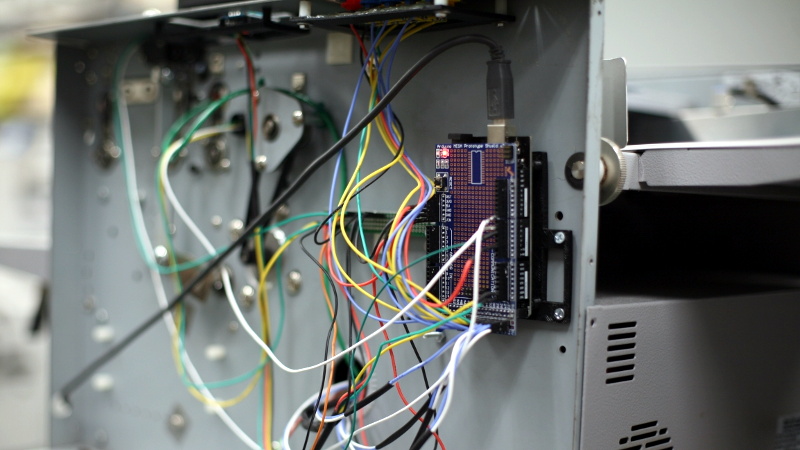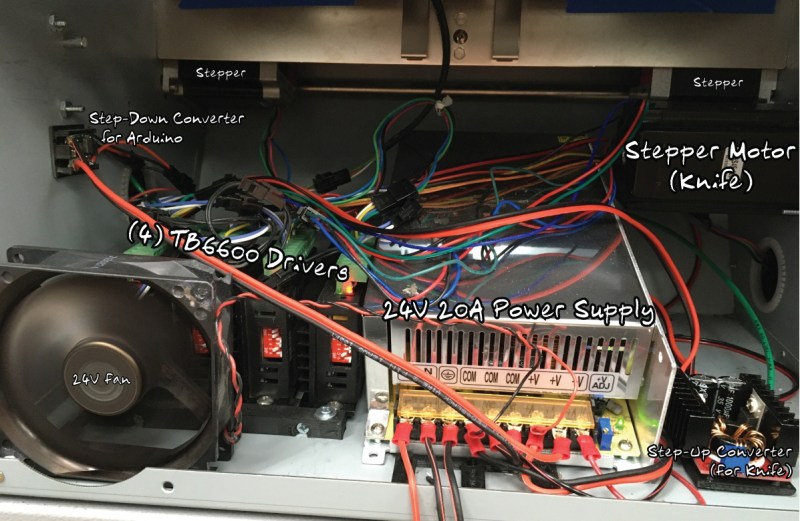It’s a common enough situation, that when an older piece of equipment dies, and nobody wants to spend the money to repair it. Why fix the old one, when the newer version with all the latest bells and whistles isn’t much more expensive? We all understand the decision from a business standpoint, but as hackers, it always feels a bit wrong.
Which is exactly why [tommycoolman] decided to rebuild the office’s recently deceased Duplo CC-330 heavy duty business card cutter. It sounds like nobody really knows what happened to the machine in the first place, but since the majority of the internals were cooked, some kind of power surge seems likely. Whatever the reason, almost none of the original electronics were reused. From the buttons on the front panel to the motor drivers, everything has been implemented from scratch.
An Arduino Mega 2560 clone is used to control four TB6600 stepper motor drivers, with a common OLED display module installed where the original display went. The keypad next to the screen has been replaced with 10 arcade-style buttons soldered to a scrap of perfboard, though in the end [tommycoolman] covers them with a very professional looking printed vinyl sheet. There’s also a 24 V power supply onboard, with the expected assortment of step up and step down converters necessary to feed the various electronics their intended voltages.
In the end, [tommycoolman] estimates it took about $200 and 30 hours of work to get the card cutter up and running again. The argument could be made that the value of his time needs to be factored into the repair bill as well, but even still, it sounds like a bargain to us; these machines have a four-figure price tag on them when new.
Stories like this one are important reminders of the all wondrous things you can find hiding in the trash. Any time a machine like this can be rescued from the junkyard, it’s an accomplishment worthy of praise in our book.

















“Two months ago I told myself this wiring was temporary.”
Hopefully everything is color coded and there is wiring and code documentation available!
An old friend used to tell me that temporary is 12 years, permanent is 6 months. I think the exact numbers he used varied or I might not be remembering them right but the idea is probably clear.
In my life since I’ve pretty much found him to be right.
Nice inspirational story on how to bring things new life and keep one less item out of a landfill. One man’s garbage…
“keep one less item out of a landfill”
Wait… He threw it away after all of that?
That’s a freaking sweet machine. Good job fixing it!
Q) What is a business card cutter? Is it a shredder for old business cards? Does it cut a piece of card stock into business card sized pieces?
A) I don’t know. Let’s try clicking the link to the original article.
Q) Where is the link?
A) Is it “machine like this can be rescued from the junkyard”? – No
Is it “keep one less item out of a landfill.”? – No
Oh, hey, the picture is clickable. Is that it? – No
— scrolls up and down about 5 times —
I guess there is no link to an original article.
Does that mean this IS the original article? Or was it just missed?
So what’s a business card cutter?
Wouldn’t it be great if every article had a link in the same place, with the same text that we could click to find the original article? Maybe there could be a form for HaD authors could submit their articles with separate form inputs for summary, maker’s name or handle and original article URL where those last two then get applied to the same spot in the same way each time the article is displayed via template. So often the links just seem to be attached to totally random text within the summary often no more prominent than several links to other, somewhat related projects.
But not this time. Nope. There doesn’t seem to be a link at all.
you just psent more time typing this up than I spent googling for a quick video of the CC-330 business card cutter, and then I had plenty of time left to say you should spend your time googling more.
Wouldn’t have thought it was such a difficult concept to grasp, but the first clickable link in a HaD post is always the one that goes to the source material.
No. I refuse to believe this comment isn’t satire.
The link to the original image gallery is literally the first one. The text is “rebuild the office’s recently deceased Duplo CC-330 heavy duty business card cutter” how much clearer could it possibly be?
Pretty unfair comment. I, too, found a link with about 2 seconds of trying. Perhaps it would be worth a bit more consideration before launching the missiles?
But I will admit, I also thought it was a shredder at first – why all the electronics. But then it became clear what it was and I saw the value of making it work again. I suspect the stepper drivers are overkill (and most TB6600 drivers these days are fake btw – the real chip doesn’t have 1:32 microstepping). Step sticks might be been a bit more cost effective.
What prints the cards on both sides to be lined up with the cutter?
At work, we use either a Ricoh C9100 or Ricoh C9200.
It is nice to see this expensive piece of equipment avoid taking a trip to the scrap heap. I taught digital electronics and one of the students was working for a tire company converting old machines to modern PLC or MCU controls. The new electronics allowed getting better precision and reliability from old machinery. However…
I worked in the technical service department of a university for 25 years and several times faculty brought in some lab equipment that had come along with the faculty from a post doc elsewhere. Upon opening the equipment to work, the insides would be all home brew and of course no documentation and no way to get hold of the person who did the work.
The moral is that if you’re doing this for yourself and/or you’ll be there forever, by all means do it. Otherwise, please document your work to make the next technician’s job more pleasant and to avoid the need back to square zero to re-do everything you did. Note: this also applies to yourself if you are the, “next,” technician on your own work five years from now. I learned that by experience!